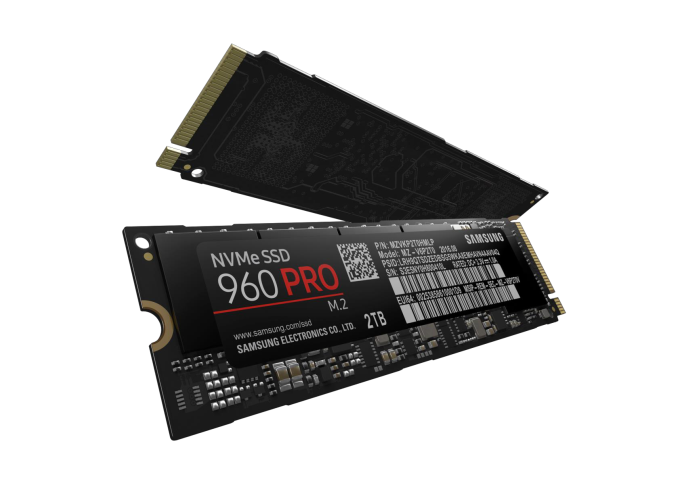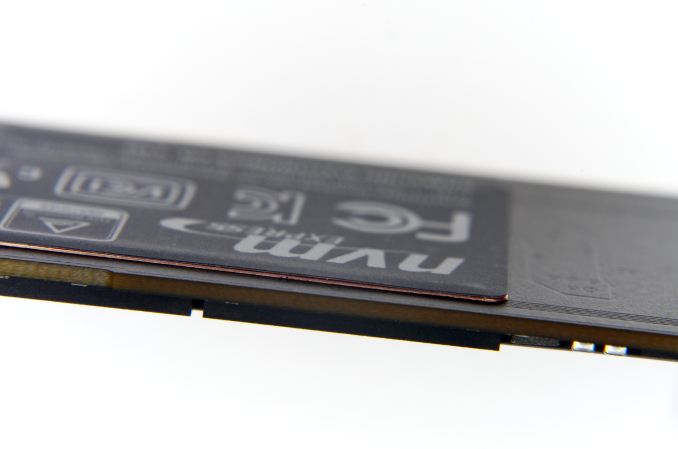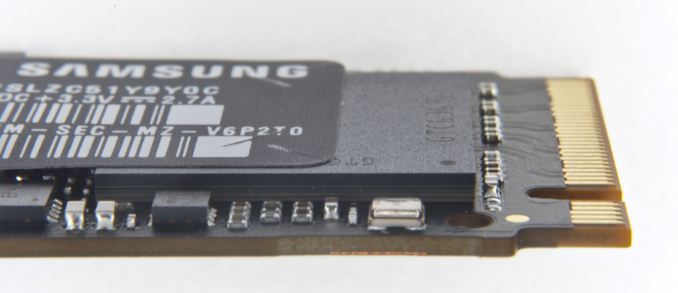The Samsung 960 Pro (2TB) SSD Review
by Billy Tallis on October 18, 2016 10:00 AM EST
A year ago, Samsung brought their PCIe SSD technology to the retail market in the form of the Samsung 950 Pro, an NVMe M.2 SSD with Samsung's 3D V-NAND flash memory. The 950 Pro didn't appear out of nowhere—Samsung had shipped two generations of M.2 PCIe SSDs to OEMs, but before the 950 Pro they hadn't targeted consumers directly.
Now, the successor to the 950 Pro is about to hit the market. The Samsung 960 Pro is from one perspective just a generational refresh of the 950 Pro: the 32-layer V-NAND is replaced with 48-layer V-NAND that has twice the capacity per die, and the UBX SSD controller is replaced by its Polaris successor that debuted earlier this year in the SM961 and PM961 OEM SSDs. However...
| Samsung 960 PRO Specifications Comparison | ||||||
| 960 PRO 2TB | 960 PRO 1TB | 960 PRO 512GB | 950 PRO 512GB |
950 PRO 256GB |
||
| Form Factor | Single-sided M.2 2280 | Single-sided M.2 2280 | ||||
| Controller | Samsung Polaris | Samsung UBX | ||||
| Interface | PCIe 3.0 x4 | PCIe 3.0 x4 | ||||
| NAND | Samsung 48-layer 256Gb MLC V-NAND | Samsung 32-layer 128Gbit MLC V-NAND | ||||
| Sequential Read | 3500 MB/s | 3500 MB/s | 3500 MB/s | 2500MB/s | 2200MB/s | |
| Sequential Write | 2100 MB/s | 2100 MB/s | 2100 MB/s | 1500MB/s | 900MB/s | |
| 4kB Random Read (QD1) | 14k IOPS | 12k IOPS | 11k IOPS | |||
| 4kB Random Write (QD1) | 50k IOPS | 43k IOPS | 43k IOPS | |||
| 4kB Random Read (QD32) | 440k IOPS | 440k IOPS | 330k IOPS | 300k IOPS | 270k IOPS | |
| 4kB Random Write (QD32) | 360k IOPS | 360k IOPS | 330k IOPS | 110k IOPS | 85k IOPS | |
| Read Power | 5.8W | 5.3W | 5.1W | 5.7W (average) | 5.1W (average) | |
| Write Power | 5.0W | 5.2W | 4.7W | |||
| Endurance | 1200TB | 800TB | 400TB | 400TB | 200TB | |
| Warranty | 5 Year | 5 Year | ||||
| Launch MSRP | $1299 | $629 | $329 | $350 | $200 | |
... looking at the performance specifications of the 960 Pro, it clearly is much more than just a refresh. Part of this is due to the fact that PCIe SSDs simply have more room to advance than SATA SSDs, so it's possible for Samsung to add 1GB/s to the sequential read speed and to triple the random write speed. But to bring about those improvements and stay at the top of a market segment that is seeing new competition every month, Samsung has had to make significant changes to almost every aspect of the hardware.
We've already analyzed Samsung's 48-layer V-NAND in reviewing the 4TB 850 EVO it first premiered in. The Samsung 960 Pro uses the 256Gb MLC variant, which allows for a single 16-die package to contain 512GB of NAND, twice what was possible for the 950 Pro. Samsung has managed another doubling of drive capacity by squeezing four NAND packages on to a single side of the M.2 2280 card. Doing this while keeping to that single-sided design required freeing up the space taken by the DRAM, which is now stacked on top of the controller in a package-on-package configuration.
Samsung's Polaris controller is also a major change from the UBX controller used in the 950 Pro. Meeting the much higher performance targets of the 960 Pro with the UBX controller architecture would have required significantly higher clock speeds that the drive's power budget wouldn't allow for. Instead, the Polaris controller widens from three ARM cores to five, and now dedicates one core for communication with the host system.
The small size of the M.2 form factor combined with the higher power required to perform at the level expected of a PCIe 3.0 x4 SSD means that heat is a serious concern for M.2 PCIe SSDs. In general, these SSDs can be forced to throttle themselves rather than overheat when subjected by intensive benchmarks and stress tests, but at the same time most drives avoid thermal throttling during typical real-world use. Most heavy workloads are bursty, especially at 2GB/sec.
Even so, many users would prefer the benefits of reliable sustained performance offered by a well-cooled PCIe SSD, and almost every M.2 PCIe SSD is now doing something to address thermal concerns. Toshiba's OCZ RD400 is available with an optional PCIe x4 to M.2 add-in card that puts a thermal pad directly behind the SSD controller. Silicon Motion's SM2260 controller integrates a thin copper heatspreader on the top of the controller package. Plextor's M8Pe is available with a whole-drive heatspreader. Samsung has decided to put a few layers of copper into the label stuck on the back side of the 960 Pro. This is thin enough to not have any impact on the drive's mechanical compatibility with systems that require a single-sided drive, but the heatspreader-label does make a significant improvement in the thermal behavior of the 960 Pro, according to Samsung.
 (click for full resolution close-up)
(click for full resolution close-up)
The warranty on the 960 Pro is five years, the same as for the 950 Pro but half of what is offered with the 850 Pro. When the 950 Pro was introduced, Samsung explained that the decreased warranty period on a higher-end product was due to NVMe and PCIe SSDs being a less mature technology than SATA SSDs. Despite having a very successful year with the 950 Pro, Samsung isn't bumping the warranty period back up to 10 years, and I would be surprised if they ever release a consumer SSD with such a long warranty period again.
Going hand in hand with the warranty period is the write endurance rating. The 512GB and 1TB models have endurance ratings that are equivalent to the drive writes per day offered by the 950 Pro. The 2TB 960 Pro's endurance rating falls short at 1200TB instead of the 1600TB that would be double the rating on the 1TB 960 Pro. When asked about this discrepancy during the Q&A session at Samsung's SSD Global Summit where the 960 Pro was announced, Samsung dodged the question and did not offer a satisfactory explanation.
The one other area where the 960 Pro does not promise significant progress is price. Despite switching to denser NAND, the MSRP of the 512GB 960 Pro is only slightly lower than the MSRP the 512GB 950 Pro launched with, and slightly higher than the current retail price of the 950 Pro. The 960 Pro is using more advanced packaging for the controller and NAND and the controller itself likely costs a bit more, but the bigger factor keeping the price up is probably the dearth of serious competition.
When the Samsung 950 Pro launched, its main competition in the PCIe space was the Intel SSD 750, a derivative of their enterprise PCIe SSD line equipped with consumer-oriented firmware. It's big and power hungry, but brought NVMe to the consumer market and set quite a few performance records in the process. The 950 Pro couldn't beat the SSD 750 in every test, but it comes out ahead where it matters most for everyday client workloads. Since then, new NVMe controllers have arrived from Marvell, Silicon Motion and Phison. We reviewed the OCZ RD400 and found it was able to beat the 950 Pro in several tests, especially when considering the 1TB RD400 against the largest 950 Pro that is only 512GB. We will be comparing the 2TB Samsung 960 Pro against its predecessor and these competing high-end PCIe SSDs, as well as three 2TB-class SATA SSDs.
| AnandTech 2015 SSD Test System | |
| CPU | Intel Core i7-4770K running at 3.5GHz (Turbo & EIST enabled, C-states disabled) |
| Motherboard | ASUS Z97 Pro (BIOS 2701) |
| Chipset | Intel Z97 |
| Memory | Corsair Vengeance DDR3-1866 2x8GB (9-10-9-27 2T) |
| Graphics | Intel HD Graphics 4600 |
| Desktop Resolution | 1920 x 1200 |
| OS | Windows 8.1 x64 |
- Thanks to Intel for the Core i7-4770K CPU
- Thanks to ASUS for the Z97 Deluxe motherboard
- Thanks to Corsair for the Vengeance 16GB DDR3-1866 DRAM kit, RM750 power supply, Carbide 200R case, and Hydro H60 CPU cooler

















72 Comments
View All Comments
JoeyJoJo123 - Tuesday, October 18, 2016 - link
Not too surprised that Samsung, once again, achieves another performance crown for another halo SSD product.Eden-K121D - Tuesday, October 18, 2016 - link
Bring on the competitionibudic1 - Tuesday, October 18, 2016 - link
Intel 750 is better. The only thing that you can tell is random write 4K QD1-4. Also it's really bad when you don't have the consistency when you need it. There's nothing worse than a hanging application, it's about consistancy not outright speed. Which reminds me...When evaluating graphics cards a MINIMUM frame rate is WAY more important than average or maximum.
Just like in racing the slowest speed in the corner is what separates great cars from average.
Hopefully Anandtech can recognize this in future reviews
Flying Aardvark - Wednesday, October 19, 2016 - link
Exactly. Intel 750 is still the king for someone who seriously needs storage performance. 4K randoms and zero throttling.I'd stick with the Evo or 600P, 3D TLC stuff unless I really needed the performance then I'd go all the way up to the real professional stuff with the 750. I need a 1TB M.2 NVME SSD myself and eager to see street prices on the 960 EVO 1TB and Intel 600P 1TB.
iwod - Wednesday, October 19, 2016 - link
Exactly, when majority ( 90%+ ) of consumer usage is going to be based on QD1. Giving me QD32 numbers is like a Mpixel or Mhz race. I used to think we reached the limit of Random read write performance. Turns out we haven't actually improved Random Read Write QD1 much, hence it is likely still the bottleneck.And yes we need consistency in QD1 Random Speed test as well.
dsumanik - Wednesday, October 19, 2016 - link
Nice to see there are still some folks out there who arent duped by marketing, random write and full capacity consistency are the only 2 things a look at. When moving large video files around sequential speeds can help, but difference between 500 and 1000 mb/s isnt much, you start the copy then go do something else. In many cases random write is the bottleneck for the times you are waiting on the computer to "do something", and dictates if the computer feels "snappy". Likewise, performance loss when a drive is getting full also makes you 'notice' things are slowing down.Samsung if you are reading this, go balls out random write performance on the next generation, tyvm.
Samus - Wednesday, October 19, 2016 - link
You can't put an Intel 750 in a laptop though, and it also caps at 1.2TB. But your point is correct, it is a performance monster.edward1987 - Friday, October 28, 2016 - link
Intel SSD 750 SSDPEDMW400G4X1 PCI-Express-v3-x4 - HHHLAND Samsung SSD 960 PRO MZ-V6P512BW M.2 2280 NVMe
IOPS 230-430K VS 330K
ead speed (Max) 2200 VS 3500
Much better in comparison http://www.span.com/compare/SSDPEDMW400G4X1-vs-MZ-...
shodanshok - Tuesday, October 18, 2016 - link
Let me do a BIG WARNING against disabling write-buffer flushing. Any drive without special provisions for power loss (eg: supercapacitor), can really lose much data in the event of a unexpected power loss. In the worst scenario, entire filesystem loss can happen.What the two Windows settings do? In short:
1) "enable write cache on the device" enables the controller's private DRAM writeback cache and it is *required* for good performance on SSD drives. The reason exactly the one cited on the article: for good performance, flash memory requires batched writes. For example, with DRAM cache disabled I recorded write speed of 5 MB/s on a otherwise fast Crucial M550 256 GB. With DRAM cache enabled, the very same disk almost saturated the SATA link (> 400 MB/s).
However, a writeback cache imply some data loss risk. For that reason the IDE/SATA standard has some special commands to force a full cache flush when the OS need to be sure about data persistence. This bring us that second option...
2) "turn off write-cache buffer flushing on the device": this option should be absolutely NOT enabled on consumer, non-power-protected disks. With this option enabled, Windows will *not* force a full cache flush even on critical tasks (eg: update of NTFS metadata). This can have catastrophic consequence if power is loss at the wrong moment. I am not speaking about "simple", limited data loss, but entire filesystem corruption. The key reason for such a catastrophic behavior is that cache-flush command are not only used for store critical data, but for properly order their writeout also. In other words, with cache flushing disabled, key filesystem metadata can be written out of order. If power is lost during a incomplete, badly-reordered metadata writes, all sort of problems can happen.
This option exists for one, and only one, case: when your system has a power-loss-protected array/drives, you trust your battery/capacitor AND your RAID card/drive behave poorly when flushing is enabled. However, basically all modern RAID controllers automatically ignores cache flushes when the battery/capacitor are healthy, negating the needing to disable cache flushes software-side.
In short, if such a device (960 Pro) really need disabled cache flushing to shine, this is a serious product/firmware flaw which need to be corrected as soon as possible.
Br3ach - Tuesday, October 18, 2016 - link
Is power loss a problem for M.2 drives though? E.g. my PSU's (Corsair AX1200i) capacitors keeps the MB alive for probably 1 minute following power loss - plenty of time for the drive to flush any caches, no?